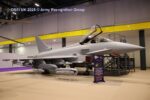At the Association of the United States Army (AUSA) Annual Meeting & Exposition in October 2025, a new vehicle-mounted mortar system—dubbed “Scorpion”—is set to undergo evaluation by the U.S. Army. Designed for rapid deployment with light forces, the Scorpion integrates either an 81 mm or a 120 mm mortar onto a lightweight tactical vehicle platform. The program reflects growing interest in mobile indirect fire solutions that can keep pace with expeditionary and airborne units.
Scorpion Concept Targets Light Infantry Firepower Gap
The Scorpion system is being developed as a response to operational gaps identified during recent deployments and exercises involving airborne and light infantry units. These formations often lack organic mobile indirect fire capabilities that can be rapidly deployed by air or maneuvered across complex terrain.
Mounted on a lightweight tactical vehicle—likely based on platforms such as the Joint Light Tactical Vehicle (JLTV) or similar—the Scorpion system aims to provide highly mobile fire support without sacrificing deployability. The vehicle is designed to be internally transportable by CH-47 Chinook helicopters or externally sling-loaded under UH-60 Black Hawks.
The integration of both an automatic loading system and digital fire control allows for fast setup times and high rates of fire compared to traditional dismounted mortars. This makes it suitable for shoot-and-scoot tactics critical in contested environments where counter-battery threats are prevalent.
Two Caliber Options: Tactical Flexibility for Commanders
The Scorpion mortar carrier will be tested with both an 81 mm and a 120 mm mortar configuration. Each offers distinct advantages:
- 81 mm variant: Lighter weight, faster rate of fire (up to ~20 rounds per minute), better suited for suppression and rapid response missions.
- 120 mm variant: Greater range (~7–8 km with standard rounds), higher explosive yield per round, more effective against fortified targets or area denial roles.
This dual-caliber approach gives commanders flexibility to tailor their indirect fire assets depending on mission requirements—whether prioritizing mobility and volume of fire or destructive power and range.
While the exact mortar systems used have not been officially confirmed at AUSA as of publication time, industry sources suggest that Elbit Systems of America may be involved in supplying key components such as computerized fire control systems. The company has previously showcased its Spear MK2 soft recoil mortar system integrated on lightweight vehicles globally.
Comparison with Existing Vehicle-Mounted Mortar Systems
The Scorpion concept enters a competitive space already populated by several proven systems:
- Patria NEMO (Finland): A turreted automatic 120 mm mortar system mounted on AMVs; widely exported but heavier than what light forces typically deploy.
- M1287 Mortar Carrier Vehicle (U.S.): Part of the Armored Multi-Purpose Vehicle (AMPV) family; designed for mechanized units rather than airborne/light infantry.
- Spear MK2 (Elbit): Lightweight soft-recoil mortar system already fielded by multiple NATO partners; possible technology base for Scorpion’s design.
The key differentiator for Scorpion is its focus on ultra-lightweight platforms compatible with rotary-wing transport—a capability not shared by most existing systems. This makes it particularly relevant for rapid reaction forces like the U.S. Army’s Global Response Force or Marine Littoral Regiments operating in Indo-Pacific littorals.
AUSA Reveal Signals Growing Interest in Expeditionary Fires
The unveiling at AUSA aligns with broader trends within NATO militaries emphasizing distributed operations and expeditionary capabilities. The need for rapidly deployable fires has been underscored by lessons from Ukraine’s battlefield use of mortars—where mobility and survivability are paramount under drone surveillance and counter-battery radar coverage.
The U.S. Army’s focus on modular fires also ties into ongoing modernization efforts under programs like Mobile Protected Firepower (MPF) and Infantry Squad Vehicle (ISV). Integrating scalable fires into these formations enhances lethality without compromising strategic lift constraints.
Next Steps: Trials Timeline and Potential Fielding
The upcoming trials will assess not only lethality but also crew survivability during firing operations, time-to-fire metrics from movement-to-shot, recoil management on lightweight chassis, integration with digital C4ISR networks (e.g., ATAK), and logistical sustainability under expeditionary conditions.
If successful during FY2026 evaluations at Yuma Proving Ground or Fort Benning ranges—as anticipated—the program could transition into limited fielding phases as early as FY2027 under Rapid Capabilities Office oversight or via Soldier Touch Points within XVIII Airborne Corps units.
Conclusion: Lightweight Indirect Fire Support Moves Forward
The introduction of the Scorpion vehicle-mounted mortar system marks a significant step toward modernizing organic fires within light infantry formations. By offering both mobility and modularity across calibers—and leveraging proven technologies from industry partners—the system could fill a long-standing gap between man-portable mortars and heavy mechanized artillery assets.










